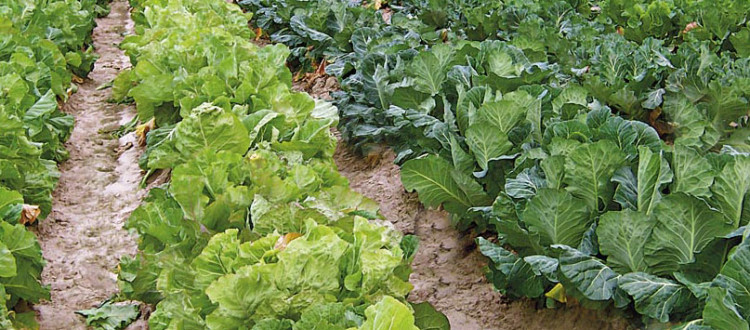Collards
Collards (Brassica oleracea) are related to cabbage and broccoli, and are part of a group of cultivars called Acephela, (“without a head” in Greek). The name “collard” is derived from the word “colewart” which means “wild cabbage plant.” The Greeks were the first to cultivate collards over 2,000 years ago along with kale.
Collards are a staple in the southern United States and are often used in recipes with ham and bacon. They have high levels of vitamin C as well as a host of other vitamins, trace minerals and the same type of antioxidants as other members of the Brassica family. Collards resemble kale and are prepared in a similar fashion. Its large, loose and waxy leaves are slightly bitter and are best eaten before they reach full maturity. Collards are an excellent cool weather crop.
How to Plant
Collards like full sun but can tolerate some shade as long as they receive at least 4-5 hours of direct sunlight a day. Plant seedlings in early spring before the last frost, or late summer, before the first frost, in slightly acidic soil, (6.5 to 6.8 pH). Space the plants at 18 to 24 inch intervals into soil that is rich in nitrogen. Prior to planting, incorporate blood meal, cottonseed meal and/or mature, composted manure into the soil and mix well with existing soil. Remove lower leaves and set in a hole that covers the stalk but lets the leaves stay above the soil line. Use mulch to help the soil retain water, suppress weeds and to help keep the leaves clean and dirt free.
Fertilizing
Collards will produce new leaves on a continual basis and require a vegetable fertilizer on a regular basis to continue producing new leaves once harvesting the lower leaves has begun. Apply as directed.
Pests
The same pests that enjoying eating other Brassica crops such as cabbage, broccoli and kale also enjoy eating the leaves of collards. These include aphids, cabbageworms and harlequin bugs.
Aphids like to eat on the underside of leaves and you might not see them unless you turn the leaf over and look carefully. They can be treated quickly by hitting them with a strong focused stream from the garden hose. Once they’re off the leaf and on the ground, they can’t get up. Aphids leave behind a sticky sap called honeydew, and the water you sprayed to remove the aphids can also remove the honeydew. If the sap is not removed, it can cause other problems such as fungal growth or even attract other bugs.
Cabbageworms are easy to spot. Remove them by hand and dispatch accordingly.
The harlequin bug is shiny and has black and red markings on its back. They will suck the leaf’s stems and cause the leaf to wilt. A good insecticidal soap can remove the nymph forms of the harlequin.
Harvesting
Large leafy plants such as collards lose water and wilt quickly once they are picked. With the wilting goes the loss of nutrients. Pluck the lower leaves off just before you head back to the kitchen so they can be stored immediately in the refrigerator. If that’s not practical, take a cooler to the garden with you. Rinsing the leaves in the garden with a bowl of water and then patting them dry is also a good idea if you’re planning on eating them straight away.
Harvest collard leaves when they get to be around 8 to 10 inches long, starting from the outside. As you harvest the leaves, the plant will keep producing new leaves. Since collards like cool weather, you can keep this cycle up well into the fall.
Recommendations for Use
- Collards and kale both have the same tough stem running through the center of the leaf. The easiest way to remove it is to fold the leaf in half, grab the end of the stem and, while gripping the leaf, pull the stem away from the leaf. Wash the leaf in fresh water and pat dry. Stack leaves together and roll them tightly to julienne.
- Collards can be julienned and enjoyed raw or sautéed, or added to stocks.

